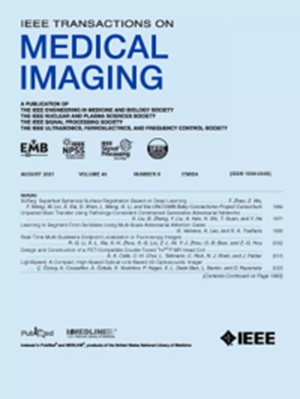Oblique Light Sheet Fluorescence Microscopy with Surface Tracking for High-speed Large-area Imaging of Conjunctival Goblet Cells.
IF 9.8
1区 医学
Q1 COMPUTER SCIENCE, INTERDISCIPLINARY APPLICATIONS
引用次数: 0
Abstract
Conjunctival goblet cells (CGCs) are specialized mucin-secreting epithelial cells, playing key roles for ocular surface homeostasis. Their examination is important for diagnosing various ocular surface disorders. However, existing imaging modalities have limitations in examining CGCs over large conjunctival regions. In this study, we present an oblique light sheet fluorescence microscopy (OLSFM) system integrated with real-time surface tracking for high-speed, large-area imaging of CGCs. The system incorporates an obliquely oriented imaging arm, providing high tolerance to variations in the sample surface. Continuous lateral scanning with pulsed light sheet illumination enables rapid large-area imaging. Additional real-time surface tracking maintains focus during the lateral scanning over the curved conjunctival surface. OLSFM successfully imaged an 8 mm² conjunctival area within 0.5 seconds in animal models, highlighting its potential for rapid CGC examination and the precise diagnosis of ocular surface diseases.倾斜光片荧光显微镜表面跟踪用于结膜杯状细胞的高速大面积成像。
结膜杯状细胞(cgc)是一种特殊的分泌黏液的上皮细胞,在眼表稳态中起着关键作用。它们的检查对诊断各种眼表疾病很重要。然而,现有的成像方式在检查大结膜区域的cgc时有局限性。在这项研究中,我们提出了一种集成实时表面跟踪的倾斜光片荧光显微镜(OLSFM)系统,用于cgc的高速,大面积成像。该系统包含一个倾斜定向的成像臂,提供高耐受性在样品表面的变化。连续横向扫描与脉冲光片照明实现快速大面积成像。额外的实时表面跟踪在弯曲结膜表面的横向扫描期间保持焦点。OLSFM在动物模型中成功地在0.5秒内成像8 mm²结膜区域,突出了其快速CGC检查和精确诊断眼表疾病的潜力。
本文章由计算机程序翻译,如有差异,请以英文原文为准。
求助全文
约1分钟内获得全文
求助全文
来源期刊

IEEE Transactions on Medical Imaging
医学-成像科学与照相技术
CiteScore
21.80
自引率
5.70%
发文量
637
审稿时长
5.6 months
期刊介绍:
The IEEE Transactions on Medical Imaging (T-MI) is a journal that welcomes the submission of manuscripts focusing on various aspects of medical imaging. The journal encourages the exploration of body structure, morphology, and function through different imaging techniques, including ultrasound, X-rays, magnetic resonance, radionuclides, microwaves, and optical methods. It also promotes contributions related to cell and molecular imaging, as well as all forms of microscopy.
T-MI publishes original research papers that cover a wide range of topics, including but not limited to novel acquisition techniques, medical image processing and analysis, visualization and performance, pattern recognition, machine learning, and other related methods. The journal particularly encourages highly technical studies that offer new perspectives. By emphasizing the unification of medicine, biology, and imaging, T-MI seeks to bridge the gap between instrumentation, hardware, software, mathematics, physics, biology, and medicine by introducing new analysis methods.
While the journal welcomes strong application papers that describe novel methods, it directs papers that focus solely on important applications using medically adopted or well-established methods without significant innovation in methodology to other journals. T-MI is indexed in Pubmed® and Medline®, which are products of the United States National Library of Medicine.
 求助内容:
求助内容: 应助结果提醒方式:
应助结果提醒方式:


